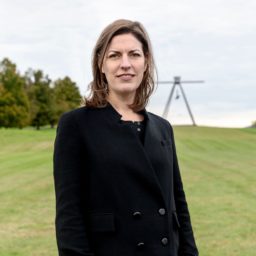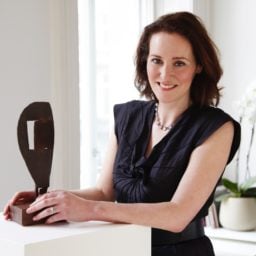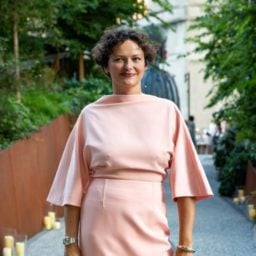The art world may be on lockdown, but it certainly does not stop. During this unprecedented time, we’re checking in with art-world professionals, collectors, and artists to get a glimpse into how they are working from home.
Curator Natalie King had just returned from a visit to Apia in March when her home city of Melbourne went into lockdown. Since then, she has been working to organize the Aotearoa New Zealand Pavilion for the 59th Venice Biennale from her home office. The exhibition—which has now moved to 2022—will feature the work of Yuki Kihara, the first Pacific and transgender artist to represent the nation at the world’s most prominent biennial.
King, an enterprise professor of visual arts at the University of Melbourne, spoke to us last month (before Australia entered its latest phase of reopening) about life online, her adventures in the kitchen, and what her new Pacific Reading Group is discussing on Zoom.
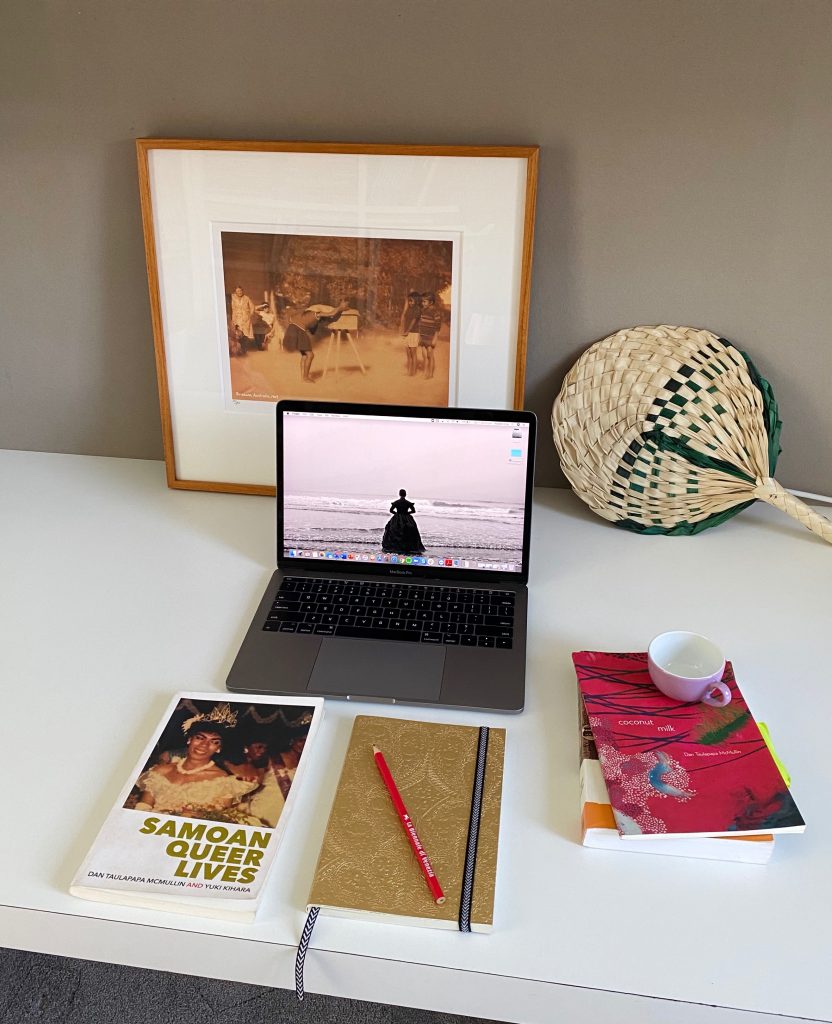
Natalie King’s desk. Photo: Natalie King.
![]() Where is your new “office”?
Where is your new “office”?
I am working from a home office in Melbourne with my three children studying in various adjacent rooms. I can hear them drumming and making Tik Tok videos. My husband is a psychiatrist; his practice has reverted to tele-health. I overlook a small garden with a lavender Jacaranda tree and I can hear birds and breeze as the city is eerily quiet. Though prolonged uncertainty has been challenging, our priorities get reorganized and the superfluous is relinquished in times of distress.
What are you working on right now (and were any projects of yours interrupted by the lockdown)?
Many of my projects are in free fall and starting to reprise. I am curating the work of Yuki Kihara for Aotearoa New Zealand’s pavilion at the 59th Venice Biennale, which has just been deferred to April 2022. Now, we have the gift of time. I am also co-curating an exhibition with Yuri Yamada at the Tokyo Photographic Art Museum as part of the Olympics called “Reversible Destiny,” which was supposed to be held last month. We are working through scheduling scenarios at present and making sure artists are remunerated. Lastly, I am working with Sami artist Katarina Pirak Sikku from Jokkmokk in Lapland [Sweden] on her race-biology archive and album research. I was supposed to visit Uppsala University in September, though this trip is likely to also be deferred.
How has your work changed now that you are doing it from home?
In some ways, I feel relieved to commune via online platforms without travel. Time is attenuated, daily rhythms recalibrated. I have tried to structure my day with some rituals and meditate daily via online classes. Zoom meetings with numerous international colleagues have provided a connection across time zones and circumstances as we reshape and rescue projects.
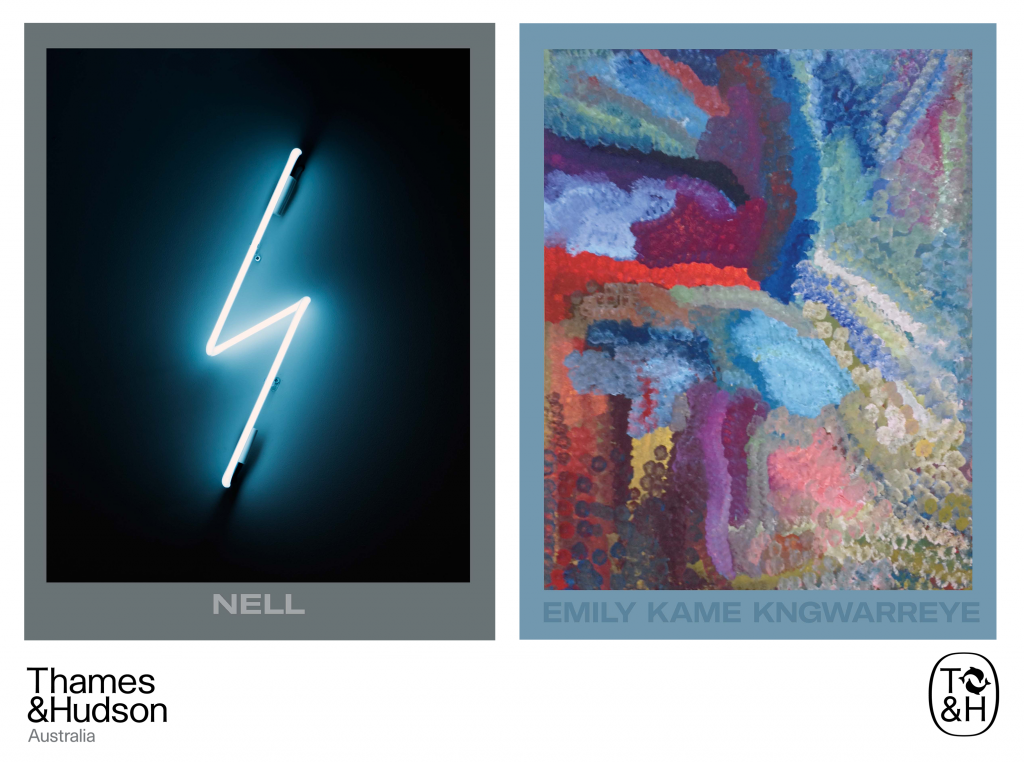
What are you reading, both online and off?
I like to read voraciously and widely. Since lockdown, a group of us has formed a Pacific Reading Group with colleagues Ioana Gordon-Smith (Wellington-based assistant curator for the Venice Biennale), Allan Haeweng (Kanak curator in New Caledonia), and Yuki Kihara (who is representing Aotearoa New Zealand in Venice). It’s a highlight of my week as we delve into Epeli Hau’Ofa’s essay Our Sea of Islands and Albert Wendt’s Towards a New Oceania. I am also reading the Polynesian poems of Dan Taulapapa McMullin in a slim volume called Coconut Milk.
Have you visited any good virtual exhibitions recently?
I am trying to vary screen time with listening, so I prefer podcasts. I am enjoying Jennifer Higgie’s new podcast series Bow Down: Women in Art. I can traverse my neighborhood with our dog while listening to Laura Mulvey on Chantal Akerman, Juliet Jacques on Claude Cahun, and Olivia Laing on Agnes Martin, which has also led me to Laing’s The Lonely City (2016). She blends research, biography, memoir, and the experience of aloneness for seven artists while reflecting on being abruptly left by her partner in New York.
Have you taken up any new hobbies?
I have started taking an online podcast training program at the University of Melbourne. I am not sure where this will lead, but I hope to be able to share and record with Yuki Kihara some of the riveting conversations that we had the privilege of having with colleagues in the Pacific.

Delectable flatbread. Photo: Natalie King.
What is the first place you want to travel to once this is over?
Actually, there are two places that I want to visit. I plan to see the current Biennale of Sydney, NIRIN, which was only open for ten days prior to lockdown. I will also return to Samoa to visit Yuki Kihara as we continue to plan the Biennale. In retrospect, it was a miracle that I traveled to Apia in March to meet with Yuki for a studio visit prior to lockdown.
If you are feeling stuck while self-isolating, what’s your best method for getting un-stuck?
I like listening to ecstatic music, so Sufi singer Abida Parveen and Egyptian songstress Umm Kulthum keep me company if the isolation takes over.
What was the last TV show, movie, or YouTube video you watched?
I have watched Hannah Gadsby’s Douglas, which is lacerating comedy—especially her hilarious analysis of Renaissance paintings, since she was originally trained in art history and curatorship in Canberra.
If you could have one famous work of art with you, what would it be?
It would be a glorious painting by Aboriginal desert artist Emily Kame Kngwarreye from Utopia community in the Northern Territory, with her dazzling dots and dreaming configurations. I recently edited a book on Emily, accompanied by an ebullient essay by Irish writer Colm Tóibín.
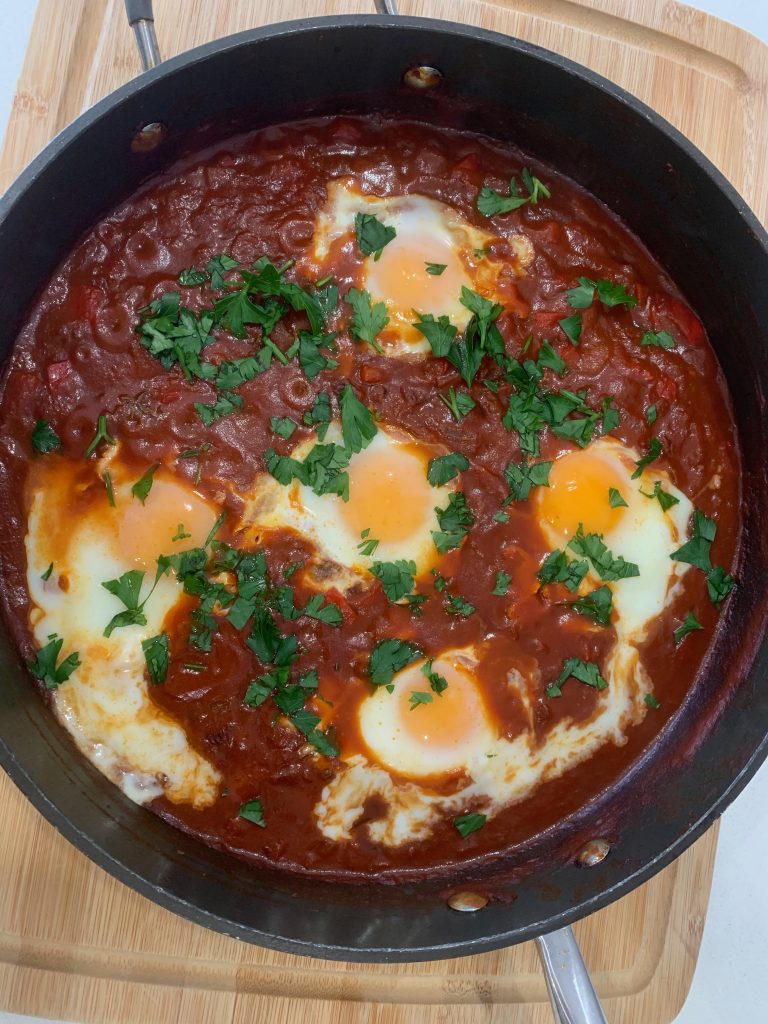
Shakshuka. Photo: Natalie King.
Favorite recipe to cook at home?
I have finally learned to make shakshuka, which comforts my family over the weekend along with za’atar flatbread.
Shakshuka
3 tbsp olive oil
2 onions, finely sliced
2 red capsicums (bell peppers), finely sliced
1 red chili, finely chopped, or chili flakes
2 tsp cumin seeds
1 tbsp paprika
2 x 400-gram (14-oz) cans of crushed tomatoes
1 tbsp brown sugar
2 bay leaves
A few sprigs of thyme
6 free-range eggs
Handful of chopped parsley
Heat oil in large frying pan. Add onions, capsicums, chili, and spices. Fry gently for 10 minutes until softened. Add tomatoes, sugar, bay leaves, and thyme. Stir to combine. Simmer gently for 20 to 25 minutes, until thickened (add a little water if it looks too thick or starts to catch). Taste and add extra chili, if desired. Make six indentations in the sauce with the back of a spoon; crack an egg into each cavity. Cover pan with a lid or foil and cook over low heat until whites are set but yolks are still runny. Scatter with chopped parsley and serve with flatbread.
Za’atar flatbread
400 grams (14 oz) self-raising flour
300 ml (1.25 cups) milk
1 tsp salt
2 tbsp za’atar
100 grams (6.7 tbsp) butter
Put flour, milk, and salt in a food processor and pulse until the mixture forms a ball. Tip the dough on to a clean work surface dusted with flour. Knead for a minute or so, to bring it together. Divide the dough into six equal pieces. With your hands, flatten one piece of dough, then use a rolling pin dusted with flour to roll into an oval shape about 4–5mm thick. Repeat with the other pieces of dough. Put za’atar and butter in a small pan over medium heat until bubbling. Remove from the heat and put to one side while you cook flatbreads. Warm a frying pan that’s a bit larger that your flatbreads over medium heat. Once it’s hot, cook each flatbread for one to two minutes per side until slightly charred. Slather the butter over the flatbreads with a spoon. Eat while they are hot.







